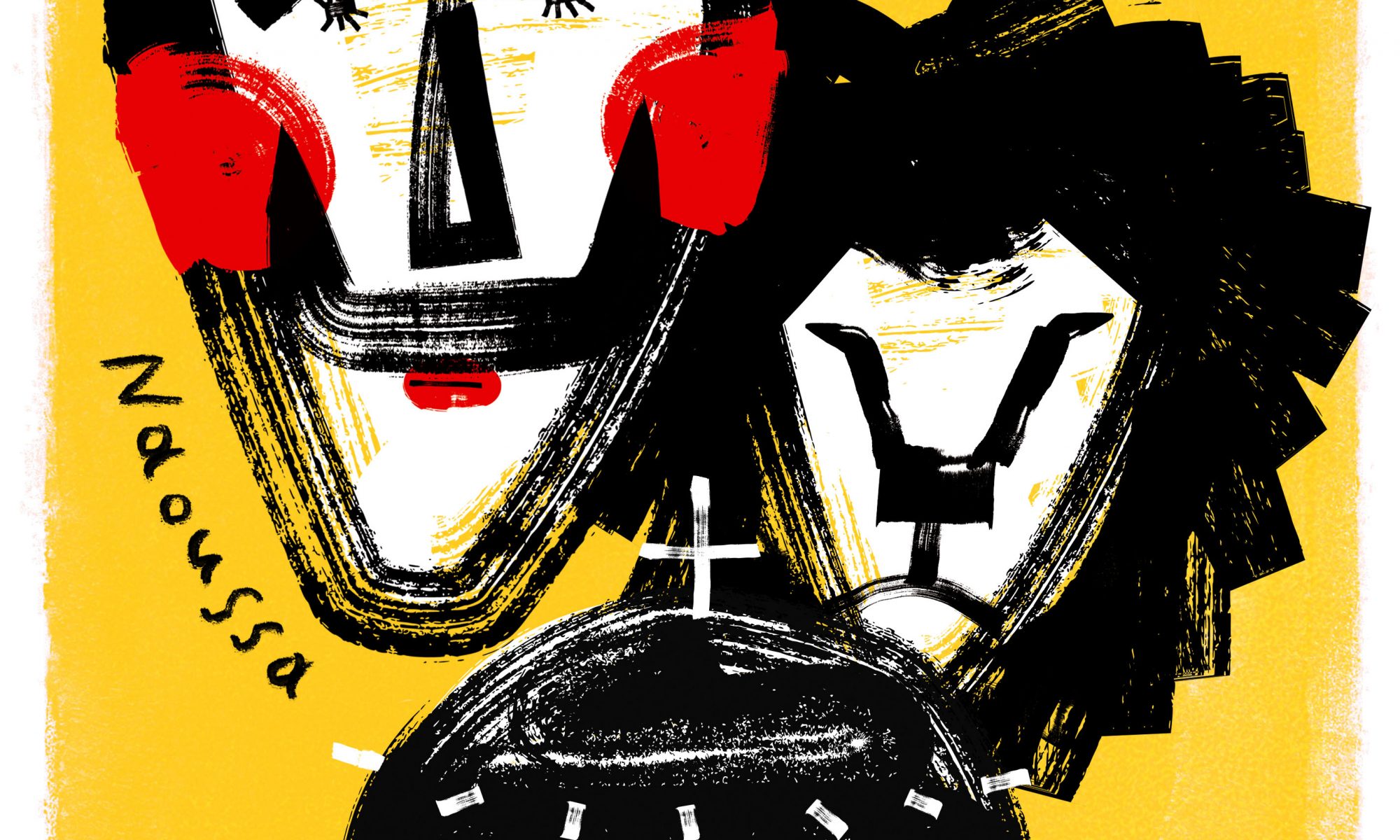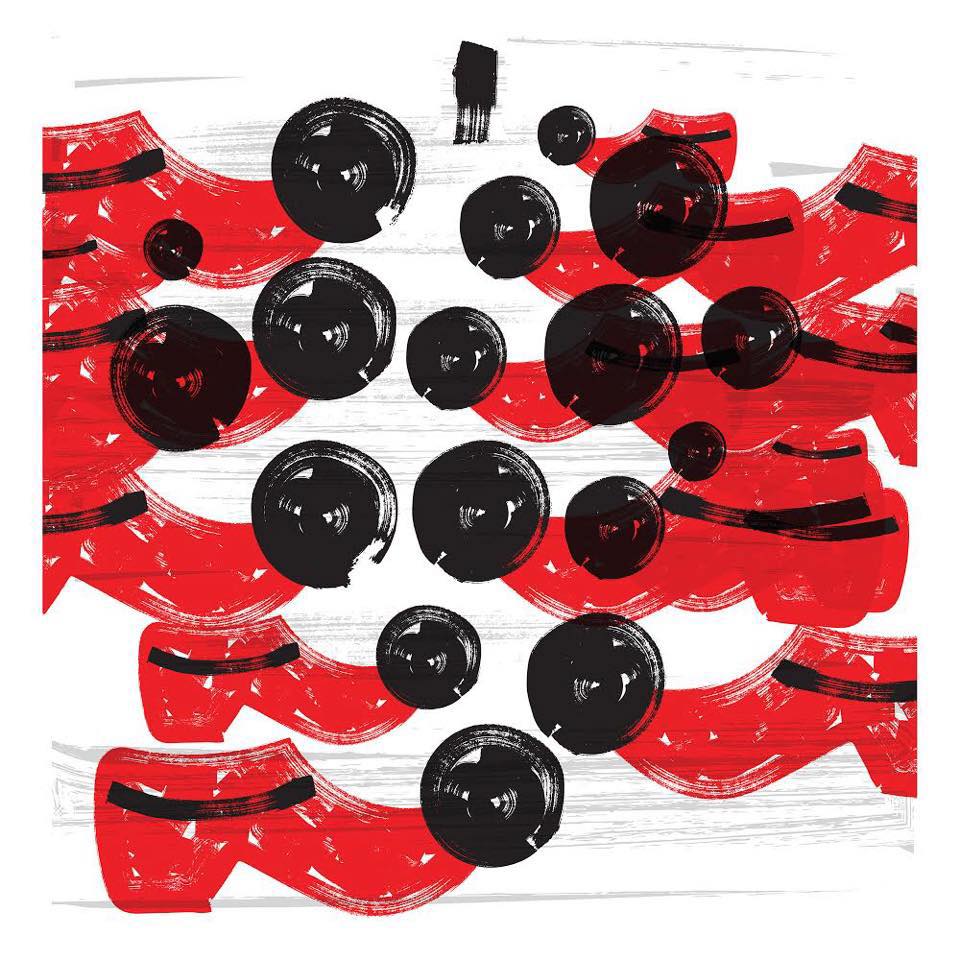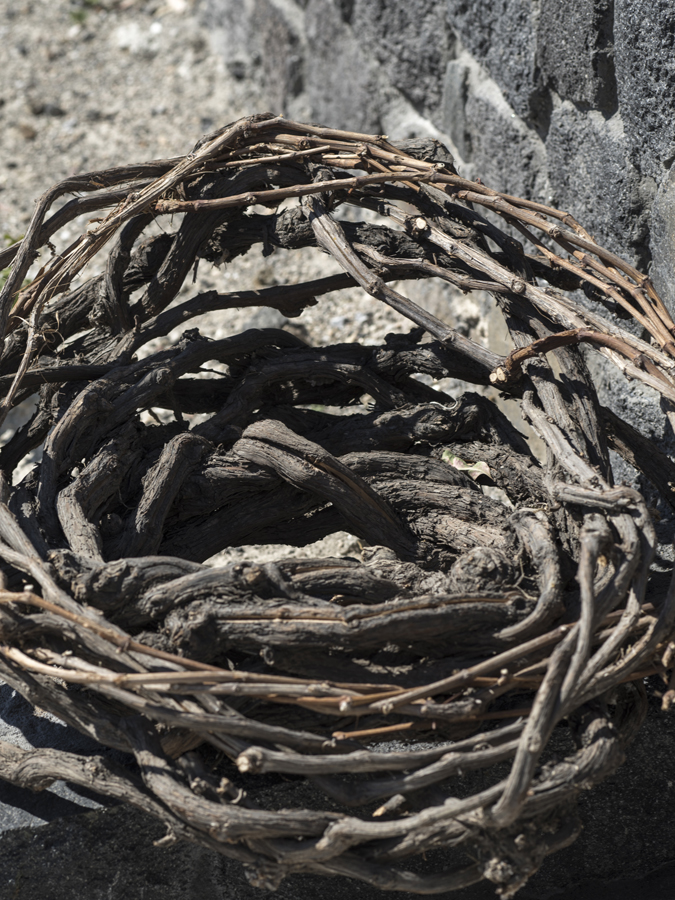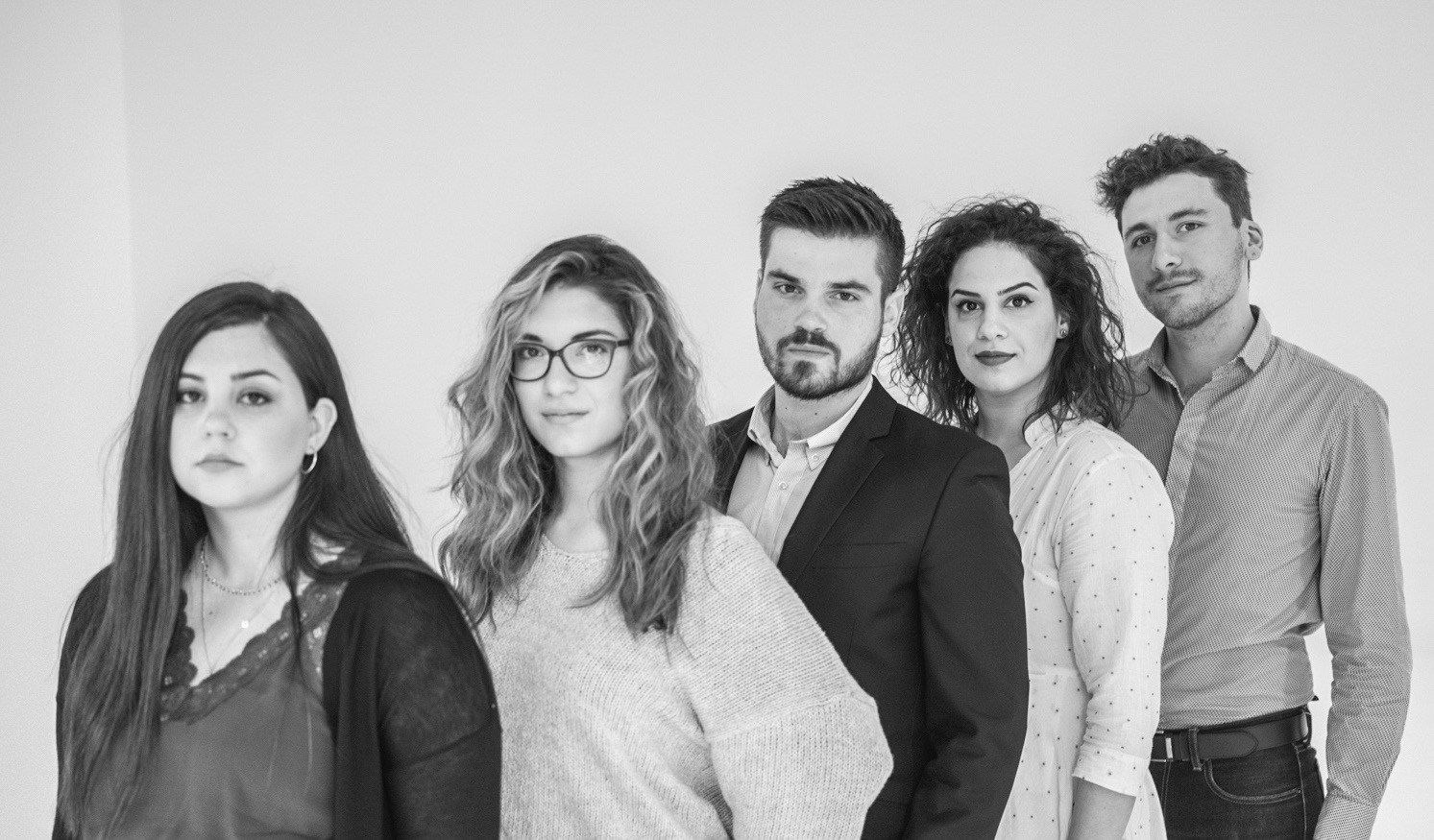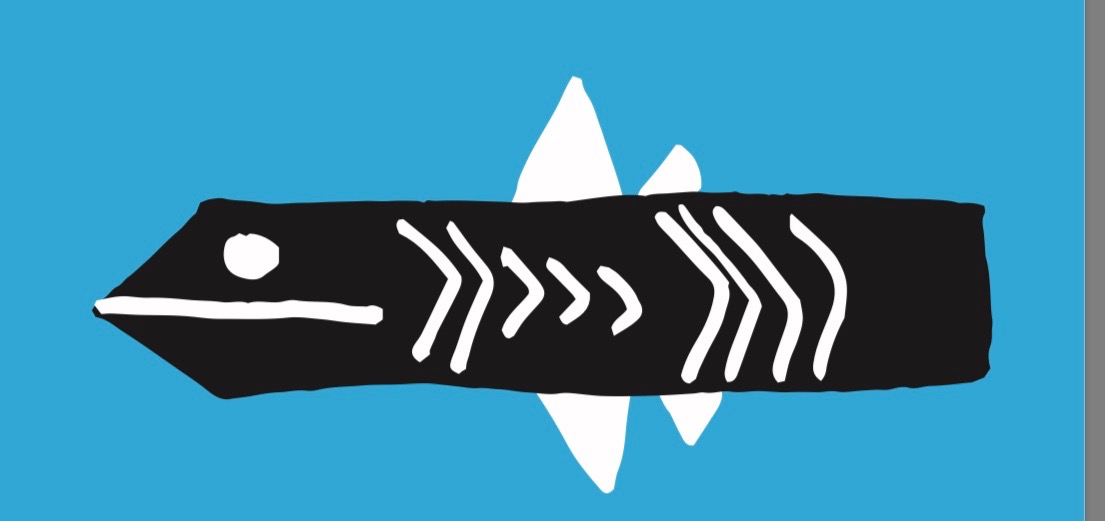Why drinking Greek wine might be the ultimate luxury | by Konstantinos Lazarakis, MW #14

Last May, the Vinexpo Bordeaux wine exhibition took place in, well, Bordeaux, and it was far and away the most poorly attended Vinexpo of all time. However, almost no one goes to Vinexpo for the exhibition anyway they’re there for the parties. During the four-day event, all the famous Châteaux organize amazing dinners and open incredible bottles. The whole point, of course, is to get invited to the best parties. The most talked about dinner of the 2019 Vinexpo, and presumably the trickiest invitation to get, was the evening event held at Château D’ Yquem, underlined in importance by the presence of its owner, Bernard Arnault, himself. Arnault is the richest man in Europe and the fourth richest in the world, at least among those whose wealth is publicly traceable. On that evening, everyone expected that the host would be invisible at the start, appear for a quick toast and then get into his helicopter and disappear. Instead, bernard Arnault welcomed everyone with a handshake and a big smile, grabbed the microphone, talked for half an hour entirely in French, and stayed on until the last guest left. And then he jumped into his helicopter.
Arnault is a most peculiar case in the world of billionaires. He is the head and founder of LVMH, the luxury giant of our times, with an annual turnover of $40 billion, out of which more than $6 billion goes to the LVMH shareholders. The list of brand names under the LVMH umbrella is dazzling and ranger from drinks (Dom Perignon, Möet, hennessy, Cheval blanc, Cloudy bay, belvedere, krug and more), to fashion (including Louis Vuitton, Celine, Dior, Marc Jacobs and Berluti), to perfumes (such as Acqua di Parma and Guerlain), to jewelry and watches (Tag Heuer, Bvlgari and Chaumet, among others) and many other sectors. While most of the other magnates of our times push us towards easier living, like gates keeping our desk tidy and bezos helping us spending less time shopping in malls or boutiques, Arnault is opening up the gates to the good life for us. One of his latest additions to the LVMH portfolio was a surprise to many people the acquisition of the Orient Express train service. Others, in hindsight, said that the purchase of a majority stake in Rimowa, the luxury luggage brand, was already pointing in the same direction. It seems that the good life is not about having things anymore. It is all about experiences. This dovetails very nicely with what knowledge is for modern people, according to writer and historian yuval Noah Harari. Harari has a formula: knowledge experience x sensitivity. We gain knowledge from filling up our lives with a range of experiences, but we must have the initial sensitivity to appreciate these experiences and then we must allow ourselves to change as a consequence. Harari stresses the importance of that multiplication sign standing between experience and sensitivity. If you have the highest sensitivity in the world but zero experiences, this results, after multiplication, in zero knowledge. The same goes for the other way round, for someone going through myriad experiences but having no sensitivity to appreciate these, let alone move onto a greater level of understanding of how rich the world can be. Imagine, for instance, the ability to taste and the food we eat. Someone could have the most sensitive palate in the world, but, for some bizarre reason, eat the same food, like fish and chips, all her life. It would be a miserable, and probably malnourished, existence. And that’s not all: a sudden exposure to another food, say sushi, would be such a shock that understanding the qualities of the new taste sensations would be impossible. The other extreme is, sadly, far more common. A person loves fish and chips but, thanks to some fortunate circumstance or another, gets exposed to all kinds of different cuisines. Still, everything is dismissed as inferior. Fish and chips remain, for them, the best food that someone can have. zero sensitivity, zero appreciation, zero change. Zero knowledge.
Let’s move on to wine. Wine is an amazing product that offers a huge gamut of styles. You can cover a long table with glasses of different wines, taste them all and find the fact that all these beverages started off from the same fruit clearly unbelievable. And yet some people do spend their entire lives drinking only one wine. These are usually winemakers, mainly amateurs but also, sadly, some professionals as well. Many, many wine drinkers, however, drink a very limited range of styles and resist everything else. “It’s always Champagne, white Burgundy or red Bordeaux for me, my dear.” No matter what these people taste, their vinous yardstick remains pretty much the same. This is made even sadder by the fact that wine is so much more than that which is in the glass. Beyond the aromas and flavors, the acidity or the body, someone can connect with the place of production, the grape variety, or even the personality of the producer. When tasting wine, you’re allowing yourself to be exposed to myriad factors, and this is priceless. All of these thoughts come to mind every summer, when I encounter people who, having picked greece as their travel destination, resist drinking greek wine. Provence rosé is great, but you can have it back home. Frankly, you can have it everywhere! There’s lots of it! Would you spend your time in greece eating only burgers and pizza?

Greek wine is very rarely the product of a clever marketing plan. believe me, there are many wines out there that are just conveying marketing concepts. Greek wine is, first and foremost, very artisanal in scale. On an annual basis, the bordeaux region alone produces more than double the wine that the whole of Greece puts out. There are only a dozen vineyard estates in greece that are bigger than the average vineyard in France. Here, most wineries are family-owned businesses of the smallest kind, meaning that the owner is the head winemaker, the head viticulturist, the receptionist, the accountant, the coffeeboy and the emerging markets analyst. These wineries deal with one of the richest oenological ecospheres in the world, because greece has an enormous number of native grape varieties which are endemic, meaning that they cannot be found anywhere else.
The sheer plethora of indigenous varieties is both proof of and testament to the long history of winemaking in this part of the world. For thousands of years, Greeks had wine as a vital part of their life, important enough to merit a god, dionysus. At the same time, they honed the wine they produced into the most appropriate beverage for their mode of consumption to go with their food, to be enjoyed in warm weather, and to have moderate levels of alcohol, since drunkenness was not tolerated. The grapes and the grape-growing places that could best serve these needs were celebrated. The others were left behind.
Today, when you have a glass of Greek wine, you’re getting millennia of both natural and unnatural selection based on culture, on worship and on everyday habits in your glass. There are very few experiences that can match this. So drink more Greek wine. It won’t taste like a Napa Cabernet or an Australian Chardonnay, but it can really, make you a better person.
No kidding.
wspc.gr
Great Wine | by Y. Kaimenakis, Wine Sommelier #issue 14

To begin with, it makes sense to clarify the meaning of the word great. Great wines do not simply establish themselves because of arbitrarily exorbitant prices or their creator’s great expectations. On the contrary, they require longterm involvement, a substantial historical record in the field of viticulture, and a producer’s commitment to a vision. I understand that this may sound vague, or complex, or even a little mythic, but believe me when I tell you it’s really much simpler than that. I remember how I was at the start of my career, visiting all the hallowed wine behemoths of Europe, expecting to witness dazzling productions, castles and cellars, mysterious and sophisticated oenological practices, and an abundance of stardust. I assure you that the people I met were very much down to earth and did only what was absolutely necessary. As Auguste Clape told me on the steep slopes of Cornas, “Nature does most of the work.”
Now, to cut to the chase: from a gustatory point of view, things are even simpler. great wines need no introductions or intricate descriptions and, more importantly for us mortals, a bottomless pit of knowledge is not a requisite to enjoy them! In some sincere way, great wines demand that we enjoy them and, as Michael broadbent once wrote, they defy any sort of analysis. Furthermore, I’ve noticed how, when a great wine is served, the whole table goes silent and an enormous smile of relief plays upon all the diners’ faces. In other words, you will enjoy a 1990 Chateaux Margaux much more in the company of good friends than with a bunch of erudite wine lovers looking to overanalyze it.
Coming back to our own case at hand, I believe that, over the last few decades, Greece has produced some very lovely and well-made wines. But that alone does not grant us the right to prematurely call ourselves ”great.“ Still, it’s only a matter of time before wines worthy of a cellar’s top shelf pedigree emerge. Now, as to which region will stand out when that moment comes, I dare say, with little to no impartiality, that it will be the Naoussa region, with its unique Xinomavro.
facebook.com/paleowinestore
VERTICAL Domaine Tatsis | by G. Michailos, dip WSET #issue 14
 Domaine Tatsis is run by Pericles and Stergios Tatsis, third-generation vinegrowers and wine producers working in the Goumenissa region and carrying on a long-lasting tradition in this small, yet significant, appellation where the varieties Xinomavro and Negoska excel. In 1996, Pericles and Stergios took over the family business, continuing to display the same dedication and passion their father had shown for highlighting the unique terroir of Goumenissa. The winery, which has been certified as an organic producer since 1998, focuses on native varieties; most of their 14ha of vineyards are planted with Xinomavro, Negoska, Roditis and Malagousia grapes, although a smaller proportion of their land is dedicated to international varieties, including Chardonnay and Cabernet Sauvignon. In 2002, they implemented a program of biodynamic viticulture, following these tenets and the biodynamic calendar devised by Maria Thun in both the vineyard and the cellar; they are not, however, certified as biodynamic producers.
Domaine Tatsis is run by Pericles and Stergios Tatsis, third-generation vinegrowers and wine producers working in the Goumenissa region and carrying on a long-lasting tradition in this small, yet significant, appellation where the varieties Xinomavro and Negoska excel. In 1996, Pericles and Stergios took over the family business, continuing to display the same dedication and passion their father had shown for highlighting the unique terroir of Goumenissa. The winery, which has been certified as an organic producer since 1998, focuses on native varieties; most of their 14ha of vineyards are planted with Xinomavro, Negoska, Roditis and Malagousia grapes, although a smaller proportion of their land is dedicated to international varieties, including Chardonnay and Cabernet Sauvignon. In 2002, they implemented a program of biodynamic viticulture, following these tenets and the biodynamic calendar devised by Maria Thun in both the vineyard and the cellar; they are not, however, certified as biodynamic producers.
In the winery, the brothers exercise very little intervention regarding the wine, trying instead to leave Goumenissa’s magnificent terroir to shine through. Fermentations start spontaneously (they haven’t used any commercial yeast since they moved to their new facilities in 2007) and they don’t employ any additives, just a small dose of sulfur dioxide, prior to bottling, if necessary. Their wines receive a long period of élevage prior to bottling. Undoubtedly, along with Sclavos, Georgas and Tetramythos, the Tatsis brothers are among the pioneers of the “natural” wine movement in Greece. If, however, you ask Pericles Tatsis, he’d rather avoid labeling his wines as such. “Since there’s no single definition of ‘natural’ wines, we see marketers more and more often branding conventional wines as ‘natural’ simply because the producers haven’t added any sulfites during the vinification method. This is very different from our philosophy,” he explains. “We would love to be seen as producers of ‘real, authentic, wines’ made with love, following in the footsteps and hon- oring the traditions of our ancestors. This is our only truth.“
From the beginning, the brothers have focused on using traditional grapes from Goumenissa: the treasured red Xinomavro and Negoska varieties found on the picturesque slopes of Mt Paiko. Their Goumenissa red blend of Xinomavro and Negoska was initially produced in 1997, and this wine can be seen as an example of a traditional approach to winemaking, to be released after a significant ageing period in order to highlight the way that the wine can be enjoyed. Tatsis Goumenissa is a wine destined to age, offering its extraordinarily impressive beauty (associated with an earthy mineral dimension and reminiscent of mushrooms and truffles) over the long term.
2012
Bright, red-berried fruit, along with intense savory notes, peppery hints and dried flowers. Bonedry palate, with powerful dry tannins and extraordinary levels of freshness. Tight and austere, at present it requires either more ageing or the accompaniment of a fatty prime cut of beef to be fully appreciated.
2008
The 2008 boasts a garnet color and aromatics (such as dried fruits and earthy notes reminiscent of forest floor and mushrooms) showing elements of development. Barolo like intensity on the palate with relatively dry tannins and some vegetal hints. It is quite impressive, with a layered complexity and, once again, it’s very powerful.
2007
Umami-like aromas such as bacon and tomato paste conquer the nose. A second swirl will also reveal sweet dried fruit notes, including raisins and sweet spices. The palate is balanced, with fantastic oak integration adding complexity, along with melted juicy tannins. A long, complex finish. Beautiful evolution and great Xinomavro typicity.
2004
Light brick color. Fully developed nose with aromas of dried fruits and herbs, smoked meat and kernels such as walnut and chestnut. Still fresh and vibrant on the palate, with finegrained tannins and great concentration. You can drink it now or forget it for another five years in your cellar.
2003
A masterpiece on the nose, it bears the typicity of a gracefully aged Xinomavro. The wine was released on the market just two years ago after spending a long period in the winery’s cellar, and it offers aromas of dried tomato, black olives, mushrooms and noble leather. harmonious and balanced with a high level of sophistication. A perfect contrast between freshness and development.
2001
It’s difficult to put its aromas into words. A bit rustic, yet beautifully evolved, with hints of deliberate oxidation, nuttiness and dried black and red fruits. However, the palate is nervy and fresh, while the tannins are a bit stripped of fruit and quite aggressive. It will probably not get any softer with extra ageing.
2000
Over the top. Fully developed nose with some fading eucalyptus aromas, dried herbs and quite oaky notes. The palate is dry and a bit astringent, not showing the great drinkability of the 2003 or 2004, and there is no potential for further ageing in the bottle. Drink now.
1999
Fully oxidative style, earthy aromas of truffles and mushrooms, and overripe tomato notes. It smells like a rainy walk in the forest. The palate lacks a bit of freshness, but it’s all about the level of ageing that you expect to see in your glass. This 20-year-old Goumenissa can easily be called memorable.
WINE JOURNAL | by G. Kontos, dip WSET # issue 14
People do not remember days they remember moments! Wines, restaurants, aromas, moments and ideas, all duly noted
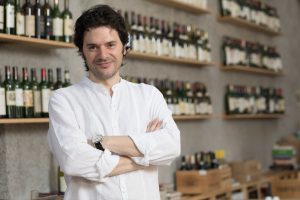
Last week, I visited the zea Marina in Piraeus and, although it was only a halfan hour’s drive from home, it made me feel as if I were on vacation. I chose to have lunch at the very popular “hams and Clams,” a brightly lit cosmopolitan oyster bar with minimalist decor overlooking the yachts and luxury cruisers in the Marina. The large windows allow in ample sunlight and you only need a few oysters, some seabream tartare, a lovely plate of seafood pasta and a glass (or two) of Apla Rosé 2018 by Oenops Wines to feel that you’re in paradise! For me, the Apla did the job: a lovely, pale, all-around rosé wine with aromas of red fruits, tomato paste and herbs, made from Xinomavro and Cabernet Sauvignon.
Malagousia – Assyrtiko is a popular greek white wine blend, from two quite different but complementary varieties. The “Sirius” 2018 white from the Georgios Lafazanis winery is a perfect example. We opened a bottle for our eldest son’s birthday and it charmed everyone; It was refreshing, food-friendly and vivid. Malagousia offers a tropical and herbaceous aromatic profile, while Assyrtiko offers texture, acidity and a mouthwatering lemony character.
The best greek wine ever made. Is there such thing? I don’t know. What I know is that Vinsanto 2002 by Estate Argyros – which Robert Parker scored 98/100 – is one of the most memorable and moving wine experiences someone can have. Seventeen years of ageing – twelve of them in old oak barrels – give the wine an alluring complexity: toffee, caramel, roasted almonds, coffee, crème patisserie, skyhigh acidity and a never-ending finish! Pick your dessert very seriously before pairing it with this gem from the volcanic island of Santorini! Either chocolate or caramel-based sweets will offer serious amounts of pure pleasure.
Celebrating greek Orthodox Easter is a big deal in greece, both spiritually and gastronomically! We spent a few days on the beautiful island of Lefkada and paired our Easter lamb with a lovely Xinomavro: Naoussa Argatia 2014 is a modern version of the grape replete with forest fruits, raspberries, tomato paste and earthy notes, and with a very refreshing acidity that dries and refreshes the palate between fatty, meaty bites! The earthy aromas of the lamb suits the wine perfectly.
There’s nothing more adventurous – and rewarding – than ageing white wines with potential. I had a bottle of Ovilos 2012 by Ktima Biblia Chora with a simple mushroom risotto and aged Gravieras havings from Naxos, and the result was stunning! After six years, this iconic Greek wine has reached its peak and offers a generous bouquet of aromas: honeycomb, quince, meat broth, truffles and minerality.
Naoussa | by T. Kartali & P. Katsatou # issue 14
Only an hour’s drive from Thessaloniki, Naoussa is an area that should not be missed by any wine lover who wants to explore greek wines. This is the land of Xinomavro, which means acidic (“xino”) and black (“mavro”) a rare, indigenous red variety which has been compared to Nebbiolo, thanks to its firm structure and its unique aromatic character. Its high acidity and tannic character produces wines which can age for decades and are suited for more experienced palates. A number of committed winemakers in this area are producing high-quality wines, combining tradition with modern winemaking techniques. Having visited the area back in 2016, when we discovered a new generation of winemakers full of energy and fresh ideas, we decided to come back, this time focusing on some of the boutique wineries as well as on the Kir-Yianni Estate, the dominant winery of the appellation. The winemakers’ passion for the great potential of Xinomavro and their dedication in promoting this unique and versatile grape variety was what impressed us most on this trip to the region. Most of the people we talked to are second-generation and third-generation winemakers, young and energetic, with great faith in what they are doing and dedicated to producing high-quality wines with the least possible intervention.
 Photography by Yiorgos Kaplanidis
Photography by Yiorgos Kaplanidis
Kir-yianni Estate
If you’re visiting Naoussa, a stop at the Kir-Yianni Estate is mandatory. In contrast to the rest of the wineries of the area, Kir-Yianni is a large estate, boasting 500 acres. It doesn’t concentrate solely on the production of Xinomavro, although the varietal wines produced from this variety are the estate’s premium labels. It was founded in 1997 by Yiannis Boutaris who, breaking away from the family business his grandfather had established in 1879, went on to create his own estate, concentrating on the production of quality wines that express the character of Naoussa’s terroir. Ramnista and diaporos are two outstanding wines which do just that, helping them to find their way to the international markets.
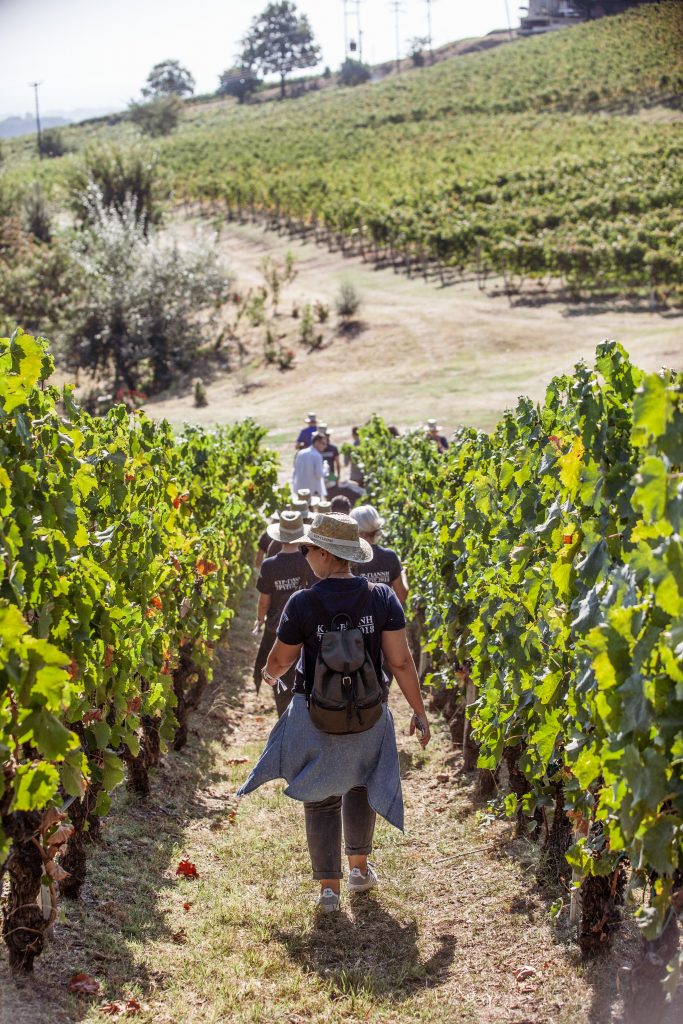 Touring the vineyard at kir-yianni Estate.
Touring the vineyard at kir-yianni Estate.
Today, the estate is managed by yiannis’ sons Stellios and Michalis Boutaris, fifth-generation winemakers. With an annual output of 500,000 bottles, Kir-Yianni is the largest winery in the area and, thanks to Stellios’ vision, it offers one of the best wine tourism experiences in the country. In addition to enjoying the magnificent views of the vineyards nestled on the rolling slopes of Mt Vermion, visitors can take tours around the winery, enjoy an upmarket picnic in the vineyards with dishes based on local recipes, or opt for a bbQ on the winery’s veranda. Naturally, the meals are accompanied by wines produced on the estate. All the options offered to the visitor, along with their seamless delivery, are the result of perfect organization by the winery’s courteous and knowledgeable staff. Although great emphasis is placed on indigenous varie- ties, kir-yianni Estate produces some excellent labels from international varieties. Drumo, a Sauvignon Blanc from a single vineyard in Amynteo, a neighboring appellation where kir-yianni also has vineyards, is a treat not to be missed.
 Stomping the grapes.
Stomping the grapes.
Domaine Dalamara
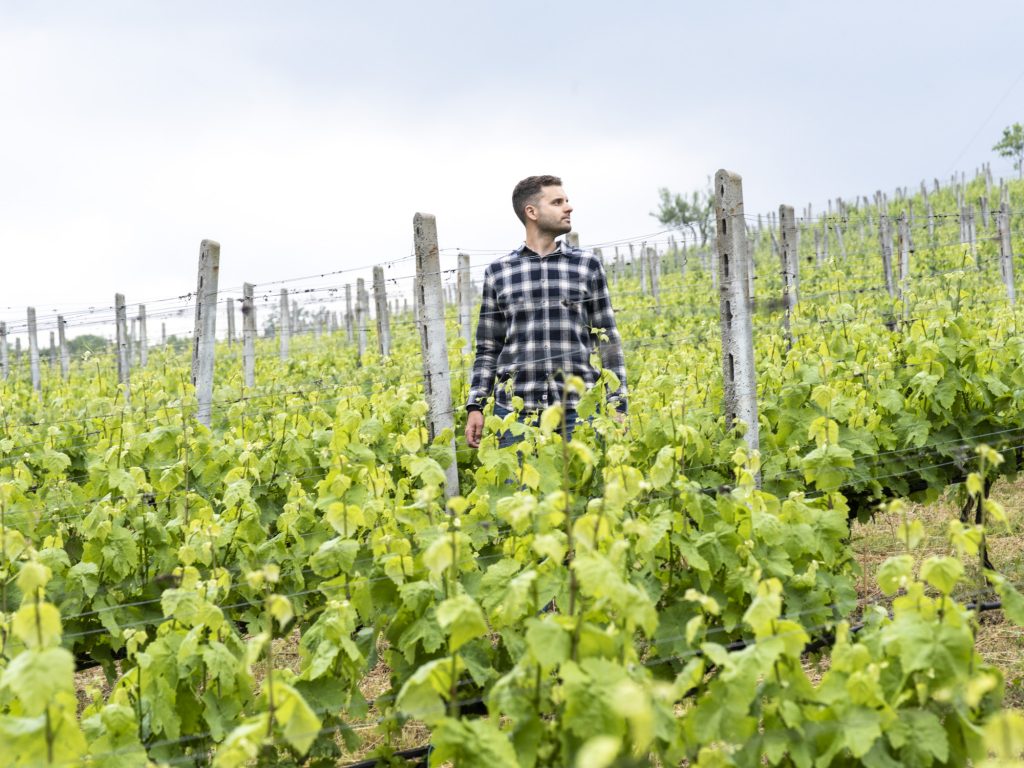 Kostis dalamaras in Paliokalias vineyard.
Kostis dalamaras in Paliokalias vineyard.
When he took over from his father in 2011, Kostis Dalamaras was the youngest winemaker in Naoussa. Following time in burgundy, where he had studied oenology and viticulture, in Catalunya , Spain, and in Alsace, France, Kostis came back to take over the small winery which had been founded in 1991 by his father yiannis. he did not hesitate to push through important changes in the winemaking techniques, applying knowledge he had accumulated abroad, but more importantly, he decided to switch the emphasis to the vineyard. About 20% of the family-owned vineyards were replanted, getting rid of varieties that Kostis thought were not serving his purpose, in order to concentrate on the indigenous varieties of the area and on Xinomavro in particular. His production is small, about 40,000 bottles a year, but his aim is to produce a high-quality wine which is the best expression of Xinomavro. As is the case with other winemakers in the area, Dalamaras seems determined to focus on this unique and versatile red variety, which is capable of producing very complex wines which age well.
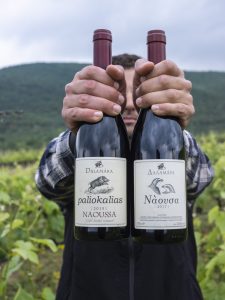
A quiet young man who adores spending time with his fiancé Maria – who also works in the winery – up on the mountain, Dalamaras believes that all the important work is done in the vineyard. He spends most of his day attending to the vineyards himself, getting a little help from his cousin Yiannis, a viticulturist, and his father who, after many decades of hard work, is now considering retirement. The small winery is surrounded by vineyards, but perhaps the most valuable plot of land is a few kilometers away in an area called Paliokalias. This particular vineyard produces the winery’s most expensive wine, Paliokalias, which is produced in an extremely limited quantity (a maximum of 8000 bottles) and does not come out every year. The climate of this area features warm dry summers and mild winters. For most of the day, the vines are exposed to the full benefit of the sun. All of the vines are grown organically, and Dalamaras tries to follow the biodynamic calendar, a philosophy he embraces. Despite the fact that he studied in Burgundy, he seems to prefer wines coming from Roussillon, France. “I think my experience in that particular wine region has influenced me more than Burgundy,” he says. The winery is located on the outskirts of Naoussa and is open to visitors.
Markovitis Winery
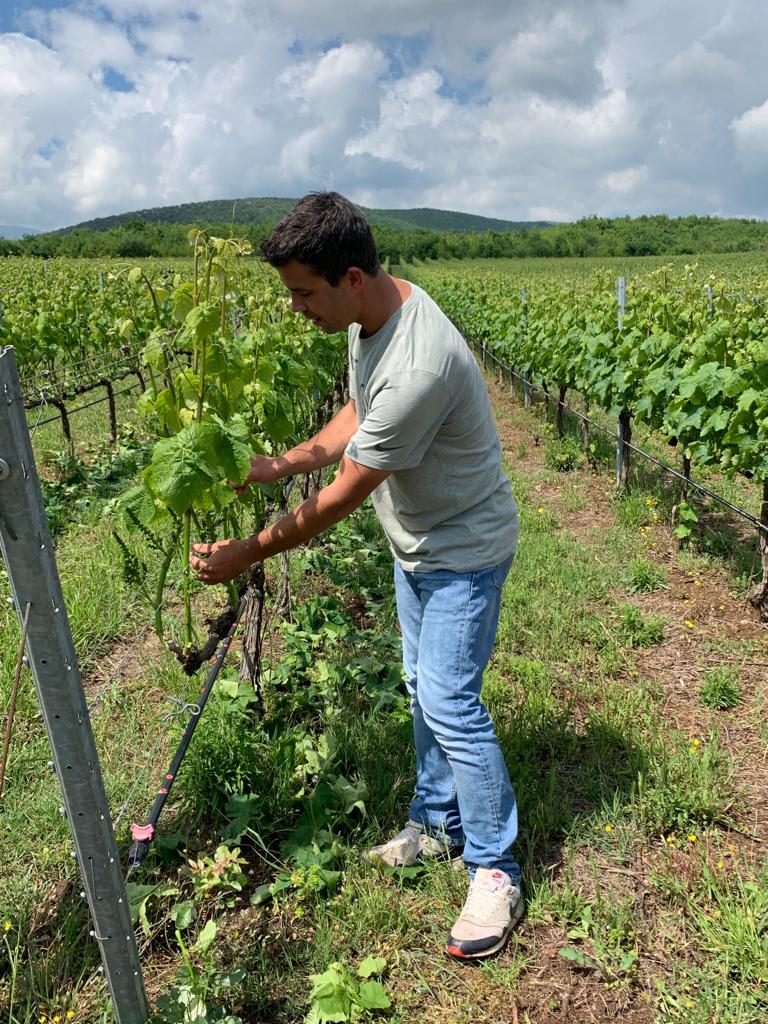 Markos Markovitis in his wineyard
Markos Markovitis in his wineyard
Markos Markovitis is arguably Naoussa’s most avant-garde wine producer. A third-generation winemaker, he took over in 2012 after his father passed away and changed everything. He only had one thing in mind, to focus on the area’s star variety. He began by replanting the whole 140-acre vineyard, replacing other varieties with Xinomavro. He then eliminated all the other wines (about 6) that his father and uncle had been producing, and focused on the production of just one, a red wine made from 100% Xinomavro. At the same time, he changed the label from Chateau Pegasus to Markovitis Winery. “You need to focus on one variety, which in my case is Xinomavro,” he says. his philosophy is very clear. “I don’t need to experiment with different varieties; all I want to focus on is this particular variety, which is indigenous, unique and offers immense possibilities.” His is a completely one-man show. He takes care of the vineyard and vinifies the wine himself, having studied oenology and viticulture in germany. “It is my german discipline that has helped me,” he jokes. Markovitis is convinced that anybody who is interested in promoting greek wine must have a very clear sense of geography. “Naoussa produces Xinomavro, Nemea produces Agiorgitiko, Santorini produces Assyrtiko,” he says. “This should be our focus.” Markovitis’ winemaking approach is based on a philosophy of non-intervention in the winery, and that’s why, he explains, “Our wines cannot be consistent. you’ll have good years and you’ll have bad years, like, for example, 2014. That year, we didn’t produce any wine. We had to sell our grapes to other producers.” In September, he will be releasing Markovitis 2016, a great vintage, according to the winemaker, a great wine with all the typical red fruit aromas of Xinomavro, very good acidity and well-rounded tannins. Trying a bottle of Chateau Pegasus 1999, we realized the amazing ageing potential of Xinomavro. The winery produces 80,000 bottles a year, 80% of which are exported to Germany, the uk, the uS and Sweden. It isn’t open to visitors.
Argatia Winery
Christoforos Georgiadis is the newest winemaker at this small winery in the area of Naoussa. Son of well-known viticulturist Haroula Spinthiropoulou, georgiadis decided to give his mother’s name to his first blend. Following a different philosophy from the previous two producers, georgiadis believes that the best way to introduce someone to Xinomavro is through a blend. Thus he created haroula, a blend of Xinomavro with two other indigenous Greek red varieties: Negoska , which grows mainly in Goumenisa, a different PDO area in northern Greece, and Mavrodafni, Cephalonia’s main red variety. “It’s an easydrinking, entry-level wine with no barrel ageing that’s doing really well in the markets abroad, especially in the united States,” he explains. As far as the PDO wines are concerned, Argatia Winery produces one Naoussa label, which it releases onto the market after five years’ maturation in the bottle. “The strong, tannic character of Xinomavro doesn’t make it very appealing to the consumers,“ he says, “so our philosophy is to keep our wines for as long as we can before releasing them onto the market. being a small winery, our space is limited; otherwise, we’d keep our bottles for even longer, seven or eight years, because this is how long a Xinomavro needs to mature.” The production is small, just 14,000 bottles. The winery is open to visitors.
OTHER WINERIES IN THE AREA 
Domaine Karydas The estate produces two labels, ktima Karyda, a typical Naoussa Xinomavro, and ktima Karydas Collectible, an exuberant blend of Xinomavro, Cabernet Sauvignon and Merlot.
Domaine Chrisochoou Its best-selling wine is Chrisochoou Xinomavro. A blanc de noir is also produced from Xinomavro.
Domaine Diamantakos Two wines are produced here, a red from Xinomavro and a white from Preknadi, another indigenous variety.
Domaine Foundis The most traditional winery of the area, this estate produces a more rustic version of Xinomavro.
INFO
kiryianni.gr
dalamara.gr
markovitiswinery.gr
argatia.gr
domainekarydas.gr
chrisochoou.com
diamantakos.gr
Santorini | by T. Kartali and P. Katsatou #issue 14
The breathtaking views from the caldera and the legendary sunsets as seen from the island have made Santorini one of the most famous destinations in the world. The island, however, is also one of the most important wine regions in greece, claiming a unique oenological ecosphere which dates back to ancient times. The island’s leading variety, Assyrtiko, has gained worldwide recognition, producing wines with a strong mineral character attributable to Santorini’s own unique volcanic soil.
 Oia
Oia
Santorini’s winemaking history stretches back 3000 years, making it one of the oldest wine producing areas in the world. What’s more, thanks to that same special volcanic soil, the vineyards here have never been affected by phylloxera. Top notch wineries produce a number of excellent wines which have found their way onto the lists of leading sommeliers around the world, making Santorini Assyrtiko a recognizable brand in the international wine market. The story of the island’s success begins with the arrival of the Boutaris family in the 1980s, which changed the commercial landscape and made Santorini wines known to domestic and foreign markets, followed by the pioneering oenological efforts of Paris Sigalas. Since then, the island’s reputation has attracted a number of winemakers from mainland greece who wish to take up the challenge of producing wine in the country’s most famous wine region. The combination of its reputation as a leading tourist destination and its unique wines has led to a boom in wine tourism on the island. Most of the island wineries offer high end wine tasting experiences, an inviting alternative to spending yet another day on the beach.
ESTATE ARGYROS

Here on the other side of the island, there are no dramatic views, only vineyards, symbols of the triumph of life over the widespread death once caused by the volcano. Surrounded by the privately owned vineyard, the estate’s winery is a modern building designed to remind the visitor of the traditional “canava” structures of Santorini. The estate, established by George Argyros in 1903, was passed down through the generations. Today, it is run by Matthew Argyros, the fourth generation of winemakers in his family. The Estate produces a series of wines – all from indigenous varieties – which they create by combining traditional and modern winemaking techniques.
Episkopi Gonia, Thira, 847 00 +30 2286 031 489 winetasting@estateargyros.com estateargyros.com
Open daily 10:00–20:00 Accommodates groups, up to 25 people
AVANTIS WINES CELLAR DOORS
The most recent addition to the list of Santorini wineries open to visitors is Avantis Wines Cellar doors. Apostolos Moudrichas, a well- known producer from mainland Greece, landed on the island in 2012. He began by collaborating with George Gavalas, one of Santorini’s most noted winemakers, and soon acquired a traditional cellar, a “canava” where he stored the big wooden barrels used for his winemaking. This year, he opened the doors of his new winery, an old open air cinema which was transformed to include those elements common to traditional wine cellars of the island. Here the visitor can enjoy wine tastings accompanied by food from a small menu based on Santorini’s traditional products. The winery produces five labels: two whites, Dolphins and Afoures, based on Assyritiko; two reds, red Wave and Saint Nicholas, based on Mandilari and Mavrotragano; and one rosé, Grace, made from Mandilari. The winery does not own its own vineyard; instead, all the grapes are sourced from different growers across the island.
Fira, 847 00
+30 22860 23140 info@avantissantorini.com avantissantorini.com
Open daily 11:00–21:00 Accommodates groups Private tours available
Boutari Winery

A pioneer in many ways, Boutaris landed on the island of Santorini in the 1980s, when the now famous Assyrtiko variety was practically unknown. His state-of-the-art winery, distinguished by Designcrave Magazine as one of the top 10 architectural wonders of the wine world, was the first to open its doors to visitors in 1989. upon his arrival, Boutaris changed the practice of late harvesting and began vinifying less ripe grapes, causing an uproar among the traditional winemakers. Since then, the Boutari Winery has been consistently producing high-quality Santorini wines, including Assyrtiko, Nychteri and the traditional Vinsanto, a dessert wine, aged for 12 years in the barrel.
Megalochori, 847 00 • +30 22860 81011 santorini.winery@boutari.gr • boutariwinerysantorini.gr Open daily 10:00–19:00 • Accommodates groups Lots of information online
Gavalas Winery
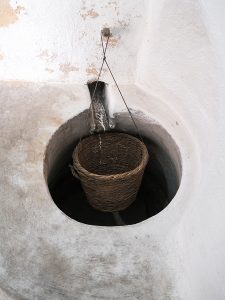
This is a small family owned winery, one of the oldest on the island. Vagelis gavalas represents the fifth generation of a family of winemakers and, together with his father George, continues the Gavalas tradition of winemaking, using the age old method of stomping the grapes for the production of their signature wine, Vinsanto. This wine ferments and ages for six years in 100-year-old barrels made from oak imported from Russia back when the wine export trade to that country was flourishing. The charming courtyard where the wine tastings are held is next to the cellar and the old “patitiri,” where the stomping used to take place. here, visitors can also take a look at an antique press and the wicker baskets used for carrying the grapes so as to get a better idea of the traditional winemaking processes of the island.
Megalochori, 847 00 • +30 22860 82552 info@gavalaswines.gr • gavalaswines.gr Open daily 10:00–20:00, last call at 19:00 Accommodates small groups, up to 10 people Tours only by appointment
Gaia Wines
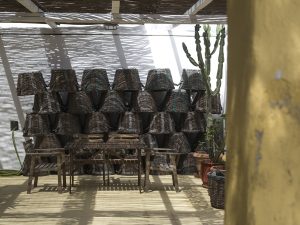
Housed in an industrial stone building which dates from the beginning of the 20th century and was once a tomato canning factory, Gaia Winery is nonetheless equipped with all the current technological equipment necessary for modern winemaking. A charming area in front of this impressive structure serves as the tasting area, so that wine lovers can sample different selections outdoors by the water. This is a truly marvelous setting for tasting Thalassitis, the winery’s best-selling label.
Exo Gonia, 847 00 • +30 22860 34186 info@gaiawines.gr • gaiawines.gr
Open daily 10:00–18:00 • Lots of information online
Hatzidakis Winery
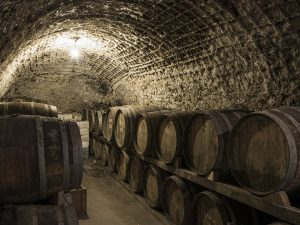
This winery boasts a 12-meter-long wine storage cellar (or “canava” as it is called in the local dialect), carved into the volcanic rock that forms the island’s soil, where all the winery’s barrels are kept. The rest of the winery was built in 2004 as an addition to this old canava, which wasn’t large enough for the 130,000 bottles that are currently produced annually. Of this output, 50% is exported to markets around the world. The winery’s founder, Haridimos Hatzidakis, who passed away two years ago, was considered one of the most charismatic winemakers in greece. Today the business is run by his family.
Pyrgos Callistis, 847 00 • +30 69700 13556 hatzidakishospitality@gmail.com • hatzidakiswines.gr Open daily except Sunday 10:30–16:00 • Accommodates small groups, up to 15 people • Bigger groups need to book a tour before 10:00 or after 17:30
Santo Wines
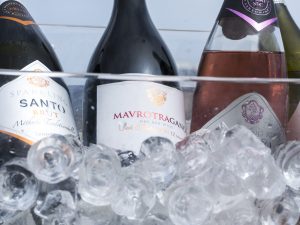
Situated right on the rim of the breathtaking caldera, Santo Wines offers its visitors a unique experience. An impressive modern building welcomes those who are interested not only in tasting the wines but also in trying the island’s local delicacies, served along with the wines or available for purchase in the winery’s deli shop. The winery was built in 1992 to house the Union of Santorini Cooperatives, whose products are marketed under the name Santo. The building itself resembles the island’s traditional stone benches. Sur- rounded by breathtaking views of the deep blue sea and the volcano, the visitor can enjoy a selection of the cooperative’s wines.
Pyrgos, 847 01 • +30 22860 28058 promo@santowines.gr • santowines.gr Open daily 10:00–19:00 • Accommodates groups Private tours available
Domaine Sigalas

The name of Paris Sigalas has become synonymous with Santorini winemaking. Sigalas has dedicated his life to protecting the historical vineyards of Santorini and to saving indigenous varieties from extinction. He has been instrumental in transforming Santorini Assyrtiko into a worldwide brand and has never stopped experimenting and exploring the tremendous possibilities that both Assyr- tiko and Mavrotragano, the island’s precious red variety offer. The Sigalas winery, hidden away on the plain of Oia, offers its visitors a unique winetasting experience that includes a degustation menu prepared on the spot, based in part on fresh vegetables produced on the domain, in the winery’s award-winning restaurant, where the visitor can enjoy magical views of the sunset. Sigalas Santorini Assyrtiko is the winery’s most popular label.
Baxes, 847 02 • +30 2286 071 644 sigalaswinetasting@gmail.com • sigalas-wine.com
Canava Chryssou
Yiannis Tselepos, a renowned wine producer from the region of Nemea, began his activities in Santorini in 2013 in collaboration with the Chryssos family, local producers who owned vineyards and a canava in the area of Pyrgos. In contrast to the trend for turning abandoned traditional canavas into hotels, Tselepos invested in creating a small winery with the goal of producing highquality wines.
Pyrgos & Emporio • +30 22710 544 440 tselepos.gr • Does not offer wine tours
Mikra Thira
The challenge of winemaking in Santorini’s unique terroir could not have left one of greece’s leading producers unmoved. Vagelis Gerovasiliou, a wellknown winemaker from northern greece, decided on a bold strategy, acquiring land not on Santorini itself but on the small island across from Oia called Thirasia. This year, a small amount of Assyrtiko (1000 bottles) was produced from the two vineyards he has here and was bottled under the label Terassea. Another wine, called Santorini and made from indigenous grapes, was also released to the market this year. looking ahead, Gerovasiliou has plans to build a winery on Thirasia.
+30 22860 717 44 • facebook.com/mikrathira/
Generation Z takes over Nemea | by T. Kartali & P. Katsatou #issue 14
Photography by Yiorgos Kaplanidis
They are part of the demographic that, among other things, grew up taking the internet for granted. They talk and write using a language all their own, causing us older folk to regard them with admiration and a touch of wonder.

This particular group of young people, however, have one other thing in common; They have common roots, share the same home region, and have all grown up in and around wineries and vineyards. Wine has always been a part of their life, and they all decided to take on what their parents had built so painstakingly, and to keep pushing forward with it. Oenologists, communications officers, hr executives and marketing directors, many with a background of studies abroad they are living proof that winemaking isn’t a simple undertaking. It’s a complex, collective profession that combines the knowledge of people from a range of specialties. These young professionals all agree that such collaborative knowledge is a necessary ingredient for success; They also agree that, in order to compete in the international market, Nemea is a brand that will need the combined efforts of a number of people dedicated to realizing their vision. This particular group became close when they participated in the Great Days of Nemea event and realized they all had the same goal in mind: to introduce their wines to the world. In the course of our interview, we were pleased to discover a new generation lucky and gifted enough to build upon the experiences of their elders, imbuing the wine world with fresh aromas and, above all, to speak in wine terms, with substance.
Dimitris Skouras
 Dimitris Skouras
Dimitris Skouras
Dimitris Skouras’ family history could have been a daunting burden. After all, when your father is George Skouras, one of Greece’s most successful winemakers and an extremely active member of the winemaking community, your life is unlikely to be simple. However, Dimitris seems to have a clear view of where he’s heading, and has only the nicest things to say about his father and their working relationship. “It really is a good partnership,” dimitris explains, ”mainly because we both like to talk things through. We’ll discuss everything, what we like, what we don’t, and often we’ll find a happy medium. Sometimes his experience is invaluable, other times a more youthful perspective is needed. I have only ever bottled one wine on my own, an Assyrtiko made exclusively for exportation to America, but I did lend a hand in producing all of last year’s wines. There’s nothing I want to change, and if there were, it would only be minor details.” The family’s winery is open to visitors, and produces about 800,000 bottles a year. Once dimitris’ sister finishes her marketing studies, she will take up a position in the family business as well. dimitris already has an impressive resume considering his age, and gained experience by working at large wineries. “Until my junior year in high school, I didn’t know what I wanted to do. I continued my French studies and went to France to study oenology. I studied viticulture and oenology at bTS, a school that focuses on practical learning, which helped me immensely. I did my Master’s in Montpellier, while taking every opportunity to gain handson experience. I worked the vintages and vineyards of some of the biggest wineries, among them la Fleur Petrus. I acquired practical experience by working at Sigalas in Santorini, at gentilini in Cephalonia and in the Napa Valley in California.” He delayed his return to greece, he says, as much as possible because he wanted to collect as many experiences as he could. his ultimate goal is to be involved in every aspect of winemaking, from production and wine tastings to traveling abroad to promote his family labels. “I don’t believe Nemea is the Tuscany of greece,” dimitris says, ”but I do think greece will finally gain recognition, and within the next few years. There are so many people abroad who are passionate about greece. The visiting tourist won’t remember the local wine or the fried squid; they’ll remember that they enjoyed that meal at a taverna by the water’s edge under the sun and the blue sky; that is the Greek experience we should be selling.”
Athena Lafazani
 Athina Lafazani
Athina Lafazani
The Lafazanis family has been in the wine business in Greece for 73 years, since 1946, when Vasilis Lafazanis came over from Asia Minor and settled in Piraeus. both his sons started working with wine from a young age. Initially, the winery was established in Magoula – this property now belongs to Athena’s uncle – but in 1993, Athena’s father transferred his operations to Nemea. He did this because of his great love for the Agiorgitiko variety, a feeling he’d had since his university days studying chemistry. In moving to Nemea, he became one of the first non-locals to involve himself in the area’s winemaking. Over the following years, the vineyard grew to 200 acres, and production shifted towards the distillation of spirits, which now makes up a large part of the company’s output. “My brother and I,” says Athena, ”are the third generation of winemakers. My father used to do everything on his own, so he’s been through all the stages of production. My parents have done a lot and I appreciate it, but it’s my generation’s responsibility to take the next step, which primarily involves increasing our prominence abroad. I got into the business five years ago when I graduated from the Athens University of Economics and Business, and I’ve taken on the responsibility for the company’s administration and marketing.” Athena deals with sales and distribution, but her main focus is on their brand image abroad. Nestor Wines was a recent addition to the company, increasing production to 1.2 million bottles a year, and the company currently exports to Europe, the united States and Australia. despite these exports however, there is a feeling that Greek wine is not properly marketed abroad.“I don’t know if it’s the wine itself or the Greek mentality, because I see this in the food industry as well,” argues Athena. “I believe it has to do with our inability to properly grasp the idea that we do something well enough to export it. Isn’t that the same problem we have with our tourism industry? I also believe we lack unity. We need to be promoting greece, and not greek wine. That’s the only way we’ll succeed. There’s little point going abroad to separately promote the Lafazanis Winery or the Skouras Estate we need to promote greek wine and greek varieties. It’s good that we’re showcasing Assyrtiko, but if that’s the only variety we take abroad, it won’t be enough; the market will get saturated. We need to market Agiorgitiko as well, particularly since Nemea is greece’s largest wine production region,” she says.
Andriani Tselepou
 Andriani Tselepou
Andriani Tselepou
Andriani, who studied in greece and london, is involved in the communications and marketing activities for her family’s winemaking business. But since it’s always a good idea in such roles to be informed about as many areas as possible, she works in production, too. Her calm demeanor not quite concealing her enthusiastic nature, Andriani’s eyes light up when she says that her brother is in New Zealand at the moment and that she’s jealous, before going on to speak of her decision to join the family business. “My father’s very lively personality made me hesitate a bit before my decision to enter the winemaking business,” Andriana says. ”But since I started working with him this past year, my impression of him has changed. I realize that my father gave us and continues to give us plenty of room for selfexpression. Nonetheless, it’s a fact that this business is the result of my father’s vision, and it’s very important for me to have him close by and be able to ask for his advice. The difference I see between my generation and the previous one is that mine has become more extroverted, particularly because we use new media technologies as work tools. both my brother and I aim to promote the wine tourism industry. We have great faith in it, and believe that it can contribute to the survival of a business.” In recent years, Tselepos Winery has seen further development, teaming up with Amphora, a Chinese investment company, to build a bioclimatic winery facility that will be open to the public. “What’s really important,” Andriani says, ”is that all of us from Nemea go abroad united, because Nemea is a very strong brand. I truly believe that, and we have platforms to get that message out. Social media plays a huge part in branding and marketing; Customers can get a clear idea of the products they’re buying, and we have a great tool that allows us to stay in contact with them, especially if they are abroad. In this way, we can communicate directly with them. Although our father still has no idea how social media works.”
Vasiliki Palivou
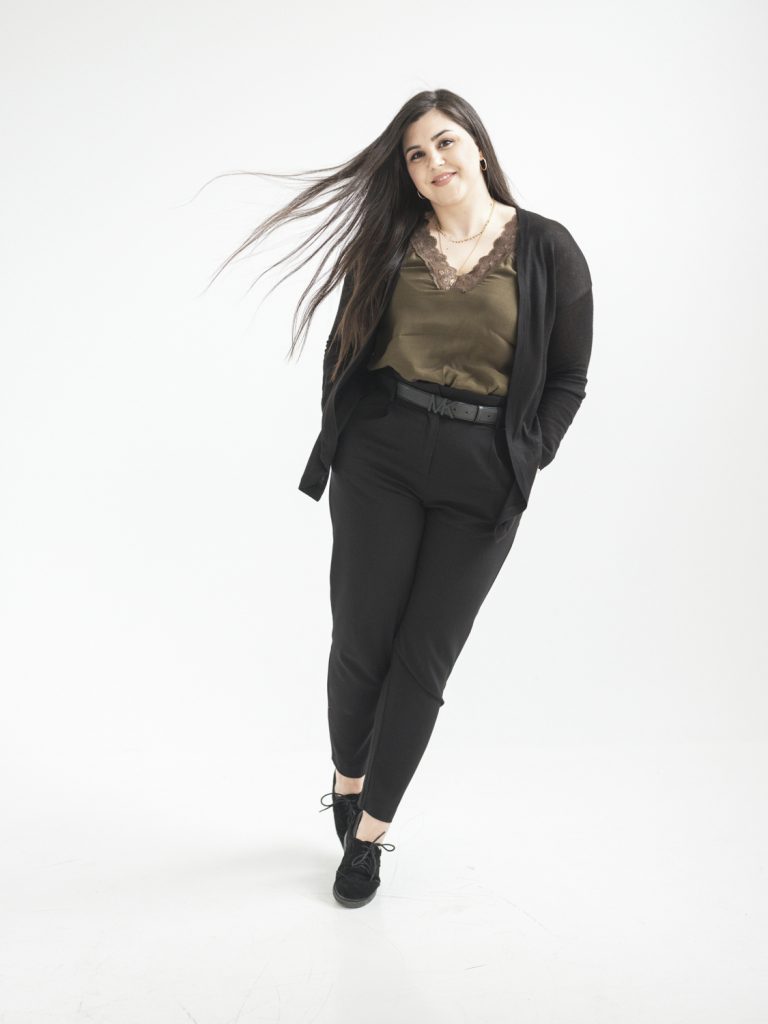 Vasiliki Palivou
Vasiliki Palivou
Vasiliki Palivou has definitely inherited her father’s energy and enthusiasm. It’s because they’re so much alike, she says, that they disagree with each other so often and push each other’s buttons, but it’s also the reason why they love each other so much. However, it’s their common vision that makes them such ex- cellent business partners. “Pretty much all the families in Nemea,” Vasiliki says, ”are involved with wine, one way or another. Our parents got into the business in 1995, bottling wine. My father was a vine grower; he believes wine is created in the vineyard. Gradually, our business grew and we opened our winery to the public. In 1999, my father had told my mother that one day people would pay to visit our winery, and she’d all but laughed in his face. Two years later, we were getting twenty thousand visitors annually. We believe wholeheartedly in wine tourism.” Wine is in Palivou’s blood. ”Basically, my sister and I grew up in the winery. Since we lived there, we were always helping out with the work the only difference is that now we’re following a schedule.” Vasiliki began studying business administration but soon switched her educational focus. She went to Athens to study interior design and then returned to Nemea to take on several responsibilities at the winery. She handles office administration, communication, and accounting, and is also responsible for the winery’s wine tourism, which is her favourite thing about the job. In her opinion, Nemea could become the #1 wine tourism destination in Greece because of its proximity to Athens, but work needs to be done.“In addition to an archaeological museum and an ancient stadium, the Nemea region boasts 13 villages, each one interesting in its own way. Having, on top of that, a number of wineries open to the public makes it an ideal region for wine tourism. However, it lacks much of the necessary infrastructure, such as hotels and restaurants, needed to develop and maintain such an industry. We need to convince the locals that Agiorgitiko is a brand that could radically improve and benefit the entire region. We have, for instance, 400 coffee houses which, if turned into rooms to let, could accommodate tourists. I think my generation is well aware of the infrastructure problem and I believe that, with the experi- ence and the guidance of our elders, we can turn things around.”
Sotiris Aivalis
 Sotiris Aivalis
Sotiris Aivalis
Sotiris’ father, in addition to being passionate about the vineyard, is also very knowledgeable about it, and before long the Aivalis winery became a reality. Until 2012, Christos did everything at the winery by himself, but things are different today. Sotiris studied oenology in Burgundy, and then went on to participate in seminars in Dijon. In 2013, Sotiris took on the family business, leaving his father to focus on the communications side of the business, for which he has a natural gift. Sotiris will never forget the first wine he bottled. ”We went out to the vineyard really early one morning, picked off a single grape and squeezed it. The juice was so dense that it dyed the rocks on the ground. That’s how the 2014 vintage was born, with the deux dieux 2016 following shortly after. It might seem that things have changed since my studies in burgundy, what with all the new pathways it’s opened up for me. But it’s not all change: I’m in absolute agreement with my father’s philosophy that, to make a big red wine, you must really work the vine, and that’s what I am trying to do.”Every year the Aivalis winery produces about 50,000 bottles and it is Sotiris’ goal to use his wines to showcase the various terroirs. “Let’s not forget that we have 13 generations of French winemakers to contend with,” he says, adding that he thinks it will be a long time before Greece is finally able to erase the ”Greek Moussaka” image from people’s minds and make them take the nation’s cuisine and its wines seriously.
INFO
ARCHAEOLOGICAL SITE
AND MUSEUM OF NEMEA
Visit the archaeological site of Ancient Nemea, including the Temple of Zeus, the ancient stadium and the site’s wonderful museum.
ANCIENT MYCENAE (25 km*)
Tour the ruins of the greatest city of the Mycenaean civilization, which played a vital role in the development of classical Greek culture.
ANCIENT CORINTH /ACROCORINTH
(31 km*)
Corinth was an important city in ancient greece, and it also played a major role in the missionary work of the Apostle Paul; he lived and preached here for 18 months.
EPIDAURUS THEATER (68 km*)
This is one of the most extensive sacred sanctu- aries in ancient greece. The temples, athletics facilities, theatre, baths, and other structures were built in an elevated valley surrounded by mountains.
STYMPHALIA (28 km*)
Visit lake Stymphalia and the Environmental Museum of Stymphalia.
NAFPLIO (40 km*)
Discover Palamidi Castle, the Fortress of Bourtzi and the National Gallery of Nafplion.
CORINTH CANAL (42 km*)
Admire this great achievement of human technology and engineering and take in some amazing views.
Wine and Food
BEST LOCAL FOOD / INGREDIENTS: • Extra virgin olive oil
• Kalamata olives
• Lemons and oranges
• Raisins, currants and vinegar
• Eggplants (especially Tsakoniki),
tomatoes
• Roosters and rabbits
• Orange-flavored sausages • Kagianas omelet (with tomatoes and cured pork) • Artichokes
A SELECTION OF NEMEA WINES TO TRY:
• Aivalis, Nemea
• Gaia Estate, Nemea
• Skouras Grand Cuvee Nemea
• Mitravelas Estate Agiorgitiko, Nemea • Tselepos ‘Driopi’ Classic, Nemea
• Palivou Estate Terra Leone Ammos
Reserve, Nemea
• Semeli Reserve, Nemea
• Cavino Nemea Reserve, Nemea
• Nemeion Estate ‘Hgemon’ Sovereign
Grande reserve, Nemea
• Lantides Nemea
• Papaioannou Terroir, Nemea • Lafkiotis Agionymo, Nemea
Apostolos Thymiopoulos | by Penelope Katsatou #issue 14
Photography by Yiorgos Kaplanidis
The philosophy of winemaker Apostolos Thymiopoulos is simple; Ιt is Xinomavro, Xinomavro, and a bit more Xinomavro. On this point, he tells me, he is unwavering. “Why should I do something different with our land? have we already drowned the world in Xinomavro that we need to change to something else?” he asks, leaving little room for debate. Undoubtedly talented – his actions have proven this – the oenologist from Naoussa is a multifaceted man.
 Apostolos Thymiopoulos in the vineyards
Apostolos Thymiopoulos in the vineyards
A believer in biodynamics, with a strong business approach to his work, Thymiopoulos is clearly passionate about what he does, which explains his popularity abroad. It also explains his wines; complex, abundantly fragrant, with finesse and plenty of what people are calling “the Naoussa new school“ element, which means you no longer need to wait decades before enjoying a wine. If, however, you did choose to wait, you would surely be rewarded. Going straight from his studies in oenology (“I only applied to a single university, that’s how determined I was to go there“) to his successful release of “Earth and Sky,“ Thymiopoulos’ journey is reminiscent of george Skouras and his first wine, “Mega Oenos.“ When I tell him this, Thymiopoulos smiles, flattered by such a comparison. He is a fan of Skouras, though slightly more obsessed with the vineyards.
A colorful stone wall welcomes visitors to Thymiopoulos Vineyards in Naoussa, showcasing the variety of rocks in the surrounding terroir, with the rocks’ colors ranging from dark grey to almost red and brown, bringing clay to mind. “Apart from the vineyards that were already owned by the family, I also bought some land. Trilofos and Fyteia, our highest elevation vineyards (at 550 meters above sea level), came later. Today, we have 29 different vineyards; 340 acres in total, all of them organically certified. Some of our partners are also certified, so as to cover needs for the foreign market. In fact, some of our partners are even greater fans of organic certification than we are. My father also cultivated organically, though he was never certified. because I still employ this method, with even greater dedication, the result is purely the progeny of earth and sky; after all, that’s the name of my label, one that I came up with when I was a student. We use whatever the land gives us; we don’t play around with machinery, or yeasts, or anything. I am resolute when it comes to that.“

Thymiopoulos’ Xinomavro wine is dissimilar to other Xinomavro wines from the region. His goal, he says, is to capture and bottle the fragrant memories of the land where he grew up. Being an oenologist, he knows how to boost aromas and to combine anthocyanins with tannins to create the bright color that has become his wine’s trademark. The winery produces 500,000 bottles, of which 400,000 are Naoussa PDO. And although the facilities and the vineyards are not yet open to the public, if oenophiles happen to be in the area, they’ll be welcome, upon appointment.
What is Xinomavro to you?
Xinomavro is a great challenge. It’s sour, acrid, watery, difficult to produce. It’s a difficult variety, which is what compels us to want to succeed in its production. It is the greek variety that challenges all other varieties worldwide. My attitude is that you have to forget what you know. Forget protocols and vinification – each year takes you in a different direction, and you have to go with the flow. I never work by the book. books tell you when it’s time to add sulfur, but if it’s sunny out, why bother with that? Biodynamic cultivation is a twofold process. On the one hand, marketing drives sales; on the other hand, your heart drives production. Then there’s homeodynamics, to make plants strong against weathering, similar to how homeopathy works for humans. After all, it’s easier to work biodynamically in Greece because of the climate. Biodynamic products are our weapon, and should be our forte. Instead, they make up a very small percentage of the market, something like five to seven percent, at best. did the Northern Italians plant different varieties than Barolo be- cause barolo is tough and tannic? No. So why should I plant something different? That would be an act of defeat, in my opinion.
What do you say to those who claim your low prices are not on a par with the high quality of your wine?
I try to make wine attractive to the world. I want people to get to know my wine; Why should I increase the prices? To buy a helicopter? We have more expensive wines in the making, from different vineyards. The quality analyses of our vinifications are very encouraging; However, for now, we’re happy with our prices. In any case, if we were to increase prices, we’d have the taxman on our back.
How did the addition of Santorini vineyards come about?
I was there in 2008-2009, helping out my friend Haridimos Hatzidakis with his harvest, and then ended up going back there regularly ever since. I miss Haridimos, as do others; he was a visionary. He wasn’t in it for the money. He never spoke about money. he wasn’t an in- vestor like so many are in this business; He was an oenologist. A family friend had given us space in his winery to create Akrotéra. Unfortunately, after Haridimos’ death, things changed. We’ve just bought land in Santorini and are preparing to build. We have many partners there. For me, Santorini is a big challenge.
Will you be creating a new label?
That depends. The harvest is what dictates how work will proceed. There’s no set recipe for success. This place and the products it yields are so unique that it does a lot of the work for you. As long as you pay attention to its needs, the land will give you its best. The land is so powerful that it would be hard not to produce a good wine.
Which wines from other vineyards caught your attention?
I try to keep up with everything, especial- ly my international competition, because I think of Greek winemakers not as competitors but as colleagues. I greatly admire flawless natural wines, such as those wines from Jura that manage to elude oenological laws and retain that intense oxidation without losing their flavor.
Before my visit to the vineyard in Naoussa, I enjoyed a very interesting vertical wine-tasting event, hosted by Apostolos Thymiopoulos and gregory Michailos, at Mr. Vertigo in Athens.
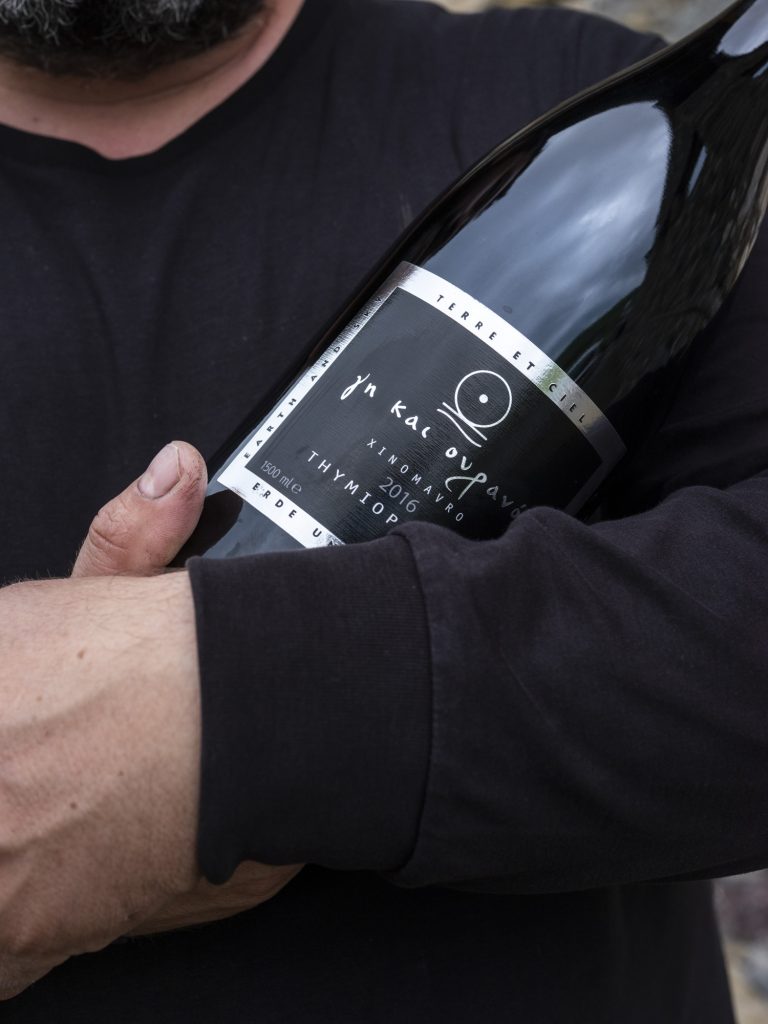
Earth and Sky
2017 Released just before Easter 2019, this wine comes from an excellent year. Compared to the 2015 vintage, fans will notice a difference in flavor, thanks to the addition of stalks. There are intense notes of strawberry, pomegranate and sundried tomato, as well as a hint of lavender. Its extractability was increased for better ageing. The color is strong, and it has quite intense tannins which, despite the wine’s youth, do not deter the drinker. It’s worth buying a bottle and forgetting about it in the cellar for a while.
2016 This is a deep red, full of red fruits such as raspberry, strawberry, tomato and spices, and hinting at the presence of vegetable notes. Its strength, and what sets this apart from other wines we tried, is its balance. It’s an impressive Xinomavro with very good tannins and acidity, high alcohol rate, and very fullbodied. It will easily survive the ageing period, but if you don’t want to wait that long, it won’t, as its creator so colorfully puts it, “make your jaw drop with tannins.”
2008 Despite its age, it retains its vibrant color. This is a traditional Xinomavro, but with unmistakable references to Nebbiolo. Its robust aromas, far from diminished, are of strawberry jam, tomato, and forest fruits, spices and vanilla. It delivers a very intense taste to the mouth, with excellently rounded tannins and the ideal acidity. It still has at least another decade of ageing ahead. To some, the leftover trace of the barrel might taste rustic, whereas to others, it provides a perfectly harmonized flavour.
2006 This was a particularly wet year, which is evident in the wine, says Thymiopoulos. It has an exceptional clarity of aromas, and has slightly less of the ”barrel” about it compared to the 2008 vintage. It’s still intensely fruity, smelling of raspberry, wild strawberry, sundried tomato, cedar and spices, and has, despite its age, strong tannins. It’s beautifully rounded, with the appropriate acidity and a very long aftertaste.
Greek Wine and Seafood | by N. Loukakis, Senior lecturer WSPC #issue 14
 Illustration by Menelaos kouroudis
Illustration by Menelaos kouroudis
Greek culinary culture is flourishing, thanks to very talented chefs who have combined modern techniques of cooking with traditional recipes and ingredients.
There are outstanding artists at work in kitchens all around greece, but the delight that Greek cuisine brings isn’t based on the skill of the chefs as much as it is on the pure soulful enjoyment of the food itself. Enjoying food is part of the festive approach that Greeks have towards life. Food is part of our social life, our daily entertainment, and our culinary culture goes far beyond the food itself. The atmosphere that surrounds the dining table is festive as well, and the aim of all such informal gastronomic events is to help everybody to connect with each other (”Phones down please!”). A perfect example of this is the weekly Sunday lunch, at which family and friends gather together to share food, wine, stories, songs and sometimes even a few dance moves. In most culinary cultures, this is called a ”sharing“ approach to food; in Greece, we simply call it ”family-style” dining. This difference in itself is an important distinction with deep connections to culture and tradition.
The stars of the Greek table are always the fresh items, and there’s nothing that says ”fresh” like seafood does. Greece is surrounded by the sea and boasts a plethora of islands and end- less kilometers of shoreline providing nearly limitless access to these maritime treasures. Meat, too, is crucial to greek cuisine, but its relative scarcity is an important part of its appeal, and the sense of sacrifice that accompanies the provision of fresh meat makes dishes such as Easter lamb or goat even more special.
The climate plays a crucial role in the creation of Greece’s gastronomic culture. For eight months of the year, we eat outside, under a hot sun or a warm star-lit sky. The bounty of the sea is perfect for such weather; it’s low in fat, easier to digest and pairs perfectly with a refreshing glass of chilled white wine. The sea provides a wide variety of foodstuffs with different textures, flavors and intensities that can be prepared using many different cooking methods. Greek white varietals offer a great diversity of styles to match the broad range of seafood options. Here, you’ll find some of our suggestions.
SAVATIANO is a variety that is grown mostly in the region of Attica, although it is cultivated in other areas around greece as well. It is a dry wine, light to mediumbodied, with medium acidity and fruity aromas. Small panfried red mullet is a good pairing with this variety, as both they have a delicate fragrance.
RETSINA is traditionally made from Savatiano, but today it’s made using other varieties as well. The new style of retsina allows the wine to express a fruitier flavor and often has raisin notes that give it more length. grilled sardines sprinkled with sea salt flakes are fantastic with this wine.
RODITIS from the mountainous region of Egialia at North-West coast of Peloponnese produces a dry medium-bodied wine, with crisp acidity, and a Sauvignon blanc-like character; It’s herbaceous, lemony and fruity. Small fish from the picarel family, including atherina (smelts), marida (whitebait) and gavros (anchovies) fried simply in olive oil, can make Japanese seafood tempura and Portuguese peixe frito blush.
ROBOLA from Cephalonia island produces a dry wine, with sharp acidity, minerality and citrus flavors, which pairs with raw clams, oysters and other shellfish. The citrus character complements salty tastes and the flavor of the sea itself.
VILANA from the island of Crete produces a wine which is dry, soft, medium bodied and with delicate flavors that pairs perfectly with grilled or fried shrimp. The soft textures and delicate flavors of both elements creates a good match.
MOSCHOFILERO from Mantinia delivers a more fragrant white wine, with crisp acidity, citrus and flowery flavors with a medium body. The next time you have some nice crispy fried calamari, instead of squeezing lemon over it, try a sip of this refreshing wine. You’ll remember us forever.
MALAGOUSIA can be found across Greece. It’s a very fashionable variety that offers a diversity of wine styles. In general, however, it produces a dry wine, with medium acidity and expressive fruity and flowery flavors and a medium body. Delicate medium-sized fish such as sea bass (preferably sautéed) marries well with the body and flavor of this variety.
VIDIANO, mainly from Crete, offers us a more concentrated wine, closer to a Viognier. It often comes with a touch of oak that adds more creaminess to the texture. A complex wine with medium acidity, it goes very well with the richer flavors of crayfish or lobster.
ASSYRTIKO from Santorini is probably one of most structured wines, without needing the use of oak, in the world. The very definition of a dry wine, it has a high acidity that is hard to find in such a hot climate. The unique mineral character of Assyrtiko is balanced by the lack of primary fruit to the nose. Large grilled large fish, such as sea bream, offer the richness that pairs best with this unique variety.
